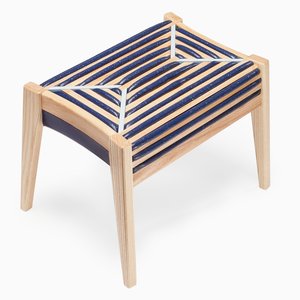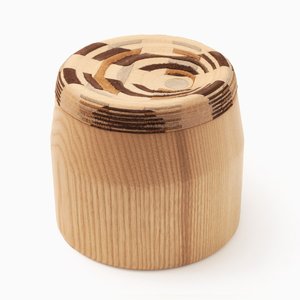Three design studios embrace computerized perfection in pursuit of the beautifully imperfect
Crafted by Robots
A set of designers has emerged that fuses the precision and reliability of science and technology with the individuality and soulfulness of traditional craft techniques. The results are innovative, repeatable yet often one-of-a-kind works that honor machine-perfect execution at the same time that they celebrate the perfection of imperfection. We sat down with three such design studios—Brit Gareth Neal, San Francisco’s SuperDuperStudio, and Israeli Dafi Reis Doron—to learn more about their work and the motivation behind their fascination with robot-crafted design.
Gareth Neal
British designer Gareth Neal launched his eponymous studio in London in 2002, and has since built a reputation for consistently pushing the boundaries of craft. Neal’s designs dance back and forth between computer-aided manufacturing and traditional techniques—sometimes even unifying the two—evoking questions of process, time, and materiality, and giving viewers pause as they consider how the terms contemporary and historical apply to the objects that stand before them.
Consider, for example, The Wish List (2014), a collaboration between Neal and Zaha Hadid. Composed of a set of sculptural, wooden carafes with flattened tails, the designs are enlivened by a bold sense of movement; at once futuristic and timeless, the vessels appear to have just landed here with a screeching halt. The graceful forms—which convincingly mimic the appearance of traditional hand carving—were created using advanced computer modeling software, and the effect is classical and human.
Neal’s George III (2013) exists in a similar realm; this form within a form consists of a rectilinear, oak chest of drawers that houses a 1780s George III commode, visible only in certain lights and from particular angles. As Neal describes it, the piece appears “as though, through the erosion of time, the fossil of its past begins to be revealed.” The chest (which, notably, is now part of the Victoria & Albert Museum’s permanent collection) was constructed by a combination of hand carving and CNC milling, further merging the old and the new—with poetic results.
From Neal’s point of view, “CNC is [essentially] just another hand tool. Its quirks are like human nature, probably because it has been programmed by people. Using tools such as the CNC machine embeds the design with a sense of the handmade through the arm of the robot, questioning the viewers’ perceptions of craft and the handmade.”
At the same time, Neal happily espouses projects that honor traditional handicraft in its purest sense. Take The Brodgar Project: What is Modern Craftsman to Me (2012), a series of handcrafted chairs and benches inspired by the traditional Orkney Chair (named for an iconic, simple, and resourcefully made chair dating back hundreds of years, which was first crafted on Orkney, an archipelago in northern Scotland, out of readily available materials—specifically, locally grown straw) and made in collaboration with Scottish artisan Kevin Gauld (one of only two professional Orkney Chair makers still working from the islands) and UK editors The New Craftsmen. Neal says, “As the environmental debate around us rages with products being flown around the world, the simple story of the Orkney Chair is one that should ground designers and craftsmen in their approach to materials, locality, and process.”
Though process is key for the innovative designer, so too is quality; creating pieces that one will want to hold on to forever—designs that say something about the interconnection between time, objects, and humanity. “My practice seeks a reconsideration of furniture design and our perceptions of the contemporary,” he says. “I use the pallet of techniques within my [specialty], rebranding processes to inspire a contemporary audience and to ensure [their] survival. . . My designs endeavor to create lifelong relationships, for a more sustainable future.”
SuperDuperStudio
San Francisco-based partners Christopher Yamane and Matthew Johnson opened shop just this past year as SuperDuperStudio (the name is riff on the 1960s Italian avant-garde architecture firm, Superstudio). The transdisciplinary design studio believes “in making things that are mysterious yet communicative, inviting but challenging, elegant and complex.” The pair’s backgrounds traverse a variety of fields—communication, graphic, and industrial design, as well as architecture, glassblowing, sculpture, and arts-based community development projects—and they experiment with systems, processes, appropriation, collage, and production methods to create singular yet accessible works. The duo enjoys navigating spaces where creative arenas overlap and designing projects with unforeseeable outcomes.
Thus far, SuperDuperStudio has produced a handful of refreshingly quirky, technology-driven pieces. 2013’s Wassiliscope (a precursor to the studio’s formal launch), for example, is a device named for Russian painter Wassily Kandinsky that translates light frequencies from a viewer’s visibility range into audible frequency, thus allowing one to “hear” color.
With Satellites (2014)—arguably the studio’s most exciting and experimental project to date—Yamane and Johnson designed a collection of one-of-a-kind, 3D-printed light sculptures. The project began as an investigation into a system for making functional objects that could be produced by anyone up for following a set of DIY instructions and manifested differently each time. The uniqueness of each kinetic mobile arises from algorithmically generated joints. As Yamane explains, “The geometry of each joint is reflective of lunar positioning data at the moment of manufacture. This includes time, the location of the 3D printer, and the position of the moon relative to the earth. In this way, each instance of the lamp is site and time specific.”
Johnson adds, “We wanted the lamps to take advantage of the new possibilities offered by personal manufacturing technologies like 3D printers. By using algorithms to generate unique components for each lamp, we saw an opportunity not only to allow consumers to intercept the manufacturing process, but also to ensure that no two lamps are the same. Because each lamp is a kit of parts that can be assembled in multiple ways, each expression endears itself to the owner that makes it.”
Following on the project’s success, SuperDuperStudio now offers unique, made-to-order Satellite kits that arrive with ready-to-assemble maple wood rods, two-way mirrors, stainless steel joints, and electrical components. (The DIY design will also remain available at instructables.com)
“To us,” Johnson says, “machine-made, one-of-a-kind objects offer an escape from many of the problems that face product design and manufacturing today: accessibility, diversity, and sustainability. These types of objects are unique, yet affordable; have limitless formal variation; and are hard to throw away because they are singular. Oneoff, machinemade objects can also reflect their owner’s individuality more genuinely than serially manufactured products and can easily adopt the personal meanings people might attach to them.”
Dafi Reis Doron
And then there’s Israeli-born designer Dafi Reis Doron. Educated at Jerusalem’s renowned Bezalel Academy, Milan’s Polytechnic, and London’s RCA—with a stint at Patricia Urquiola’s Italian studio—Doron launched her eponymous studio in 2012. The emerging designer divides her time between studio locations in London and Tel Aviv, where she focuses on designs that synthesize past and present production techniques to challenge and catalyze the next generation of design. As the designer notes, “I am always looking to create objects that have never been seen before, either in terms of their process of production, the materials used, or shape.”
Doron’s innovative 75% Control collection (2012), for example, introduced a new application for a traditional furniture cushion material—polyurethane foam. Instead of hiding the material beneath furniture fabric, as is customary, Doron created a process that transforms polyurethane into the star of the show with pleasingly tactile, decorative results. The collection’s chairs and stools are constructed in wood with open molds. Doron then pours colored polyurethane inside the molds, which react chemically (Doron prefers not to share the details of this part of the process for the time being, as a patent is pending), expanding and adhering to the furniture structure. The end-result is a raised surface that boasts the look and feel of fabric. As the collection’s title suggests, it is at once amorphous—from the free rise of the foam—and accurate—thanks to the precise location of the structure.
Similarly, Doron’s CAD Weaving project (2011-present) experiments with known materials—in this case, leather and wood veneer—in combination with computer-generation techniques, for unexpected results. Thick layers of leather and veneer are glued together in a mold in a crisscross manner to form a solid block. Doron then simulates the same block on the computer, and determines the final shape and pattern she wants to achieve. Finally, she cuts the material with a CNC machine using the shape code she’s programmed in 3D software. The final patterned surfaces appear as though they’ve been woven—hence the series’ title—and represent a new means of constructing “woven” material, or creating “upholstered” furniture and accessories.
Research for the CAD Weaving project initially began while Doron was at the RCA; the project ultimately came to life thanks to a 2011 collaboration with Fendi. While working with Fendi’s leather, Doron realized the innovative material combination she’d been looking for, and set about constructing a set of woven stools. More recently, she’s applied this same process to create woven jar tops—inspired by traditional kitchen jars with cloth covers—that sit atop petite walnut and ash containers. Doron recalls, “I imagined a future scenario where every household has a CNC machine, similarly to home printers today, and how as a result of that, traditional crafts and techniques will merge with the modern tools.”
And speaking to the larger value of craft-minded, machine-made designs, Doron says, “For me, these object belong to the next generation of industrial production, as they merge the qualities of both worlds into a single product. Personally, I am not seeking to create one-of-a-kind objects, but objects that will challenge and affect [the forward trajectory of] industrial production.”
-
Text by
-
Anna Carnick
Anna is Pamono’s Managing Editor. Her writing has appeared in several arts and culture publications, and she's edited over 20 books. Anna loves celebrating great artists, and seriously enjoys a good picnic.
-



